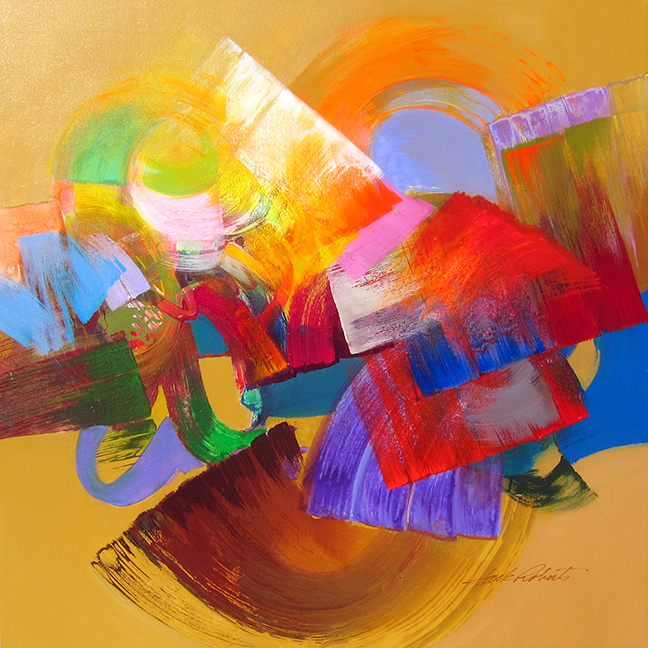 |
Morning Shadows
Judy Feldman
36" x 30", oil on canvas |
Can dilly-dallying help the artistic process?
By
Judy Feldman |
www.wildemeyer.com
I’ve been thinking about writing this blog for a while. But different commitments and distractions have gotten in the way. Is that procrastination? Sometimes, that happens before I start a painting. Then, I can really procrastinate, with laundry, gardening, cooking, whatever is a good stalling technique. When people ask me how long it takes to do a painting, like “Morning Shadows,” I guess I have to add a few hours to the process.
Why do creative people procrastinate? Is it productive? I had to ask some fellow artists.
 |
Zebrid Display Tactics
Timothy Chapman, 16" x 20" acrylic on panel |
Timothy Chapman admitted that procrastination is part of his personality. “I know it’s there, and I just have to deal with it,” he said. But, he explained that for him, procrastination is like drawing your bow to get ready to make art. “I need some time to reflect,” he explained. “I’ll go into my studio and clean up a bit, then play a quick game. But once I get going, I get into the zone, and paint for hours.”
Timothy studied biology in school, and is fond of depicting animals in his own way., which, according to him, is “basically inaccurate, by using humor, irony and a surrealistic sensibility that is not available to a scientist.” So part of his process involves looking through reference material – often Victorian animal portraiture – and then doing some sketches, before going on to a canvas. “Sketching deflects procrastination,” he explains. Great idea!
 |
Evening Guardian Ritual
Timothy Chapman, 36" x 48" acrylic on panel |
Once Timothy examines old animal engravings and starts riffing on their weirdness (these illustrators rarely saw the real thing), he gets his ideas. How to explain “Zebrid Display Tactics” except to note how wonderfully the red blanket shows off the black and white stripes. And, what about the flying? “Gravity is optional is most of my paintings,” he says. Levitation is also present in “Evening Guardian Ritual,” a mélange of species and patterns. Timothy says that these patterns develop as he is painting, as do the drips that dribble down from the sky.
 |
Landscape #868
Albert Scharf, 36" x 48", oil on canvas |
Albert Scharf has a ritual he performs before painting. A student of Kabbalah, he tries to guide his thoughts beyond barriers to creativity. “I think about the energy of the day, and try to open myself up spiritually” he says. “In Kabbalah, creative thinking is closest to wisdom, the path to seeking unknown knowledge. So, procrastination can be productive.”
To get started on a project, Albert says he often visualizes a color palette, and then puts paint on his canvas. “Then, I’m off and running,” he says. “I work back and forth to fix mistakes on an unconscious level. Ultimately, that becomes a painting.”
 |
Landscape 802
Albert Scharf, 54" x 42", oil on canvas |
Albert’s luminous cloud paintings, such as “Landscape 868” convey a dreamy state of mind to me, stimulated by a beautiful sunrise or sunset. His very low horizon, with just a hint of land, gives lots of room for his ethereal clouds. Looking at “Landscape 802,” I feel as if they are moving across the canvas. The glowing highlights on the ground below seem to reflect the setting sun.
Another arsenal in his combat against procrastination is to work on three or four canvases at a time. “I focus on a main one, but if problems arise, I can go to another, without getting off track.” He also has other, more playful projects, to “work in a different creative mode and lighten up the tendency to get into a rut.”
Jeff Cochran, the third artist I called, seems to have a good handle on procrastination. “I basically make myself sit and drink coffee until I can’t sit anymore,” he says. I’m guessing that enough caffeine will propel him into his studio. Since his move to Taos, New Mexico, Jeff has been painting landscapes of areas surrounding his home. So he does need to muster up the energy and enthusiasm to load up his van and get out to do the plein air studies he paints, before doing the larger ones in his studio.
 |
Ray of Light in the Pasture (study)
Jeff Cochran, 48" x 50", oil on canvas |
“I try to do eight or nine paintings outdoors,” he says. “I like to work near my home, since I really don’t want to drive very far. Painting is a full-time job for me so I do work every day, unless I struggle, in which case, I wait for the next day.”
Looking at Jeff’s beautiful landscapes, I can sense his love of the painting process. “Mountain Range in Autumn,” for example, shows his knowledge of color and his energetic brushstrokes (caffeine-related?) transform a quiet scene into something exciting. Jeff said that sometimes, he’ll create a scene that reflects his outdoor observations, then he adds more drama, as in his painting entitled “Ray of Light in the Pasture.”
 |
Mountain Range in Autumn
Jeff Cochran, 48" x 52", oil on canvas |
Jeff is single, so he can do things like make his recent impulsive trip to the Baja in Mexico, set up camp and paint a while with no distractions. But, maybe I’m just rationalizing. Maybe some of us creative types are just super skilled at creating techniques for delaying the work we love.
In closing, I’d like to quote from a line by Ellen DeGeneres: “Procrastinate now, don’t put it off!”
You can see more work by
Timothy Chapman,
Albert Scharf,
Jeff Cochran, and
Judy Feldman at
Wilde Meyer Gallery.














